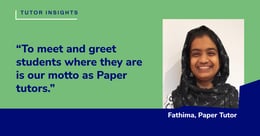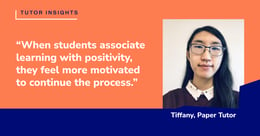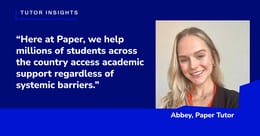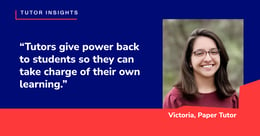
There’s no ‘one-size-fits-all’ in learning
Everybody needs a little help from time to time. Tutor Samantha explores how individualized support from Paper™ can help students get the personalized assistance they need.
As a recent college graduate, I can still vividly recall the challenges of being a student. Typical challenges students may face include difficult math problems and bothersome grammar rules.
However, the classroom setting itself may be a struggle for some students as well. Unfortunately, a setting with multiple learners can be detrimental to students who may need extra support in different areas. And many students will find an area that’s challenging at some point in their academic careers.
When I was studying as an English major in college, I thrived in creative writing class—but I needed extra resources to get through chemistry. As a Paper tutor, I see similar situations play out in the Live Help setting as learners seek additional resources for challenging assignments and subjects.
Based on my own experience as both a student and a tutor, I firmly believe that every individual student deserves to have their unique needs met with positive, adaptable, patient, engaging, and respectful instruction.
Using the Paper Method to achieve student-driven goals
Tutoring in an online setting comes with its own unique set of challenges for both students and the tutors. However, Paper tutors strive to use the Paper Method in their virtual classrooms to build rapport with students and foster a love of learning.
P is for ‘positive’
We focus on maintaining a positive attitude throughout sessions with students. Positivity is a hallmark in the Paper classroom, as a simple “Great job on that tough question!” can help struggling students feel more confident in their work.
A is for ‘adaptable’
Being able to adapt to each individual student’s subject, grade level, and needs is a unique benefit that Paper offers its users.
P is for ‘patient’
Sometimes, one of the most discouraging experiences students can encounter in their academic lives is when an educator expresses impatience with them or their work.
At Paper, we demonstrate patience with each student. The virtual classroom should be a safe place for students to learn through their mistakes as well as celebrate their successes.
E is for ‘engaging’
Learners are better able to understand and absorb knowledge when they’re engaged during sessions, so tutors have a plethora of creative ways to keep students’ attention.
R is for ‘respectful’
We strive to treat all students with respect so these learners can feel safe, comfortable, and confident during our sessions. An environment in which students’ contributions are not respected can be invalidating for students and harmful to the overall learning process.
Adaptability is key to the Paper Method
Respectful dialogue, engaging material, patient explanations, and positive feedback will look different during every session—and that’s because every student is unique. Therefore, the Paper Method emphasizes tutors’ ability to be adaptable. This skill of adapting, in my opinion, is one of the key components that makes Paper’s tutoring special.
We use tools in the virtual classroom setting to spur positive and engaging feedback and discussions with students. These approaches include using the information provided on the student’s profile; employing a mixture of inquiry-based learning and scaffolding; and properly identifying the problem to boost students’ understanding. No matter the subject, these three approaches can be applied to each session.
Student profiles: An overview of students’ learning histories
Once students enter our virtual classrooms, tutors can view a student-created profile with information such as their grade level and their comfort with certain subjects.
This gives us a glance into what kind of studying and writing techniques might be most helpful to each student. Some students prefer using the whiteboard, for instance, while others want a back-and-forth dialogue. This profile also serves as an indication as to what kind of background knowledge students may have with the subject based on their grade level.
We can then use the information gathered from the students’ profiles to begin a personalized greeting. This greeting includes the student’s name, a question about what brings the student to Paper, and an acknowledgment of relevant information in their profile (such as their comfort level with the subject being tutored). This personalized greeting is the launching pad for tutors to build rapport with students and to show them that we’re ready to adapt and work through their academic needs together—all at their pace.
Inquiry-based learning and scaffolding: A foundation for furthering understanding
Another way that we can adapt to students based on their grade level or individual academic needs is by using a combination of inquiry-based learning and scaffolding.
Because Paper supports everyone from kindergarteners to high schoolers, we need to find the perfect balance with every student between asking thought-provoking questions that help them learn the material and scaffolding up to fill in gaps where prior knowledge is missing.
Scaffolding can be especially helpful with younger students who could need extra support and may not be ready for higher-level critical thinking questions.
Identifying the issue: Getting to the root of misunderstanding
One of the final steps toward overcoming students’ unique challenges is discovering what the roots of their issues are. By digging into these issues, we can create individualized plans so that learners and tutors can tackle challenges together.
The process of identifying the issue starts with the personalized greeting and can continue throughout the dialogue as students and tutors build rapport and establish what students’ expectations are for the session.
With these expectations in mind—along with inquiry-based learning, scaffolding, and the information provided on the student’s profile—we’re able to adapt to each student and hopefully exceed their expectations for the session.
Meeting students where they are in their academic journeys can be incredibly helpful to many learners who are seeking extra academic assistance. The Paper Method—and especially its adaptability—gives tutors the guidelines to create a welcoming, engaging environment with the intention of supporting individual students and their unique academic challenges.

Samantha, Paper Tutor
Paper supports students and educators in school districts by providing unlimited, 24/7, and multilingual Live Help and Review Center support.
Who are our tutors?


.png?width=260&height=136&name=Blog-Tutor-Insights-Niya%20(1).png)

.png?width=260&height=136&name=Blog-Tutor-Insights-Cynthia-1%20(1).png)

